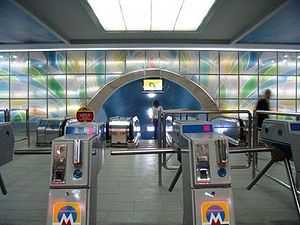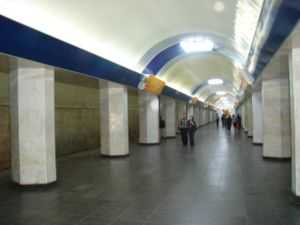Tbilisi Metro
 | |||
| Overview | |||
|---|---|---|---|
| Native name | თბილისის მეტრო | ||
| Locale | Tbilisi, Georgia | ||
| Transit type | Rapid transit | ||
| Number of lines | 2[1] | ||
| Number of stations | 22[1] | ||
| Annual ridership | 93.9 million (2012)[2] | ||
| Website | Tbilisi Transport Company | ||
| Operation | |||
| Began operation | 11 December 1966 | ||
| Operator(s) | Tbilisi Transport Company | ||
| Number of vehicles | 170[1] | ||
| Train length | 3–4 cars | ||
| Technical | |||
| System length | 27.1 km (16.8 mi)[1] | ||
| Average speed | 33.2 km/h (20.6 mph) | ||
| |||
The Tbilisi Metro (Georgian: თბილისის მეტროპოლიტენი) is a rapid transit metro system in Tbilisi, Georgia. Opened on 11 December 1966 it became the 4th Metro system in the former Soviet Union. Like most ex-Soviet Metros, most of the stations are very deep and vividly decorated.
The Tbilisi Metro comprises two lines, 27.1 kilometres (16.8 mi) in length, serving 22 stations.[1] In 2012, the Metro transported 93.9 million passengers, a significant increase to the 85.6 million passengers served in 2011.[2] It is operated by the Tbilisi Transport Company, which began operation the same year as the Tbilisi Metro, in 1966.[3]
Network





- Current lines
| # | Name | Opened | Length[1] | Stations |
|---|---|---|---|---|
| 1 | Akhmeteli–Varketili Line | 1966 | 20.1 km (12.5 mi) | 16 |
| 2 | Saburtalo Line | 1979 | 7.0 km (4.3 mi) | 6 |
| TOTAL: | 27.1 km (16.8 mi) | 22 | ||
- Planned lines
| # | Name | Opened | Length | Stations |
|---|---|---|---|---|
| 3 | Rustaveli–Vazisubani Line | Planned | 5 km (3 mi) | 5 |
Operation
As of 2012, the system consists of two lines,[1] serving 22 stations,[1] operating on 27.1 kilometres (16.8 mi) of route[1] and 62.5 kilometres (38.8 mi) of track.[1] Of the 22 stations, 20 stations are below ground and two are surface level. Of the subterranean stations, 16 are deep level and 4 shallow. The former comprise 6 pylon stations, 5 column and 5 single vaults (built to the Leningrad Technology). The shallow stations consist of three pillar-trispans and one single vault (Kharkov Technology). Due to Tbilisi's uneven landscape, the Metro, particularly the Gldani-Varketili line, travels above ground in two locations.
In 2005, it was estimated that a total of 105.6 million people used the Metro annually,[4] though the 2012 Metro passenger figure was actually 93.9 million.[2] Carrying them are a fleet of 170 metro vehicles (as of 2012, 117 modernized rail vehicles, and 53 Old type 81–717/714 vehicles),[1] operating from two depots.[1] The train models used are identical to those of other ex-Soviet Metros. Although station platforms are built to accommodate five-carriage trains, currently four- and three-carriage trains are used on Line 1 and Line 2, respectively. The cost per single ride is 50 tetri, however when using the Metromoney Card (a stored value card available for purchase at metro stations) riders can transfer or reenter the system for 90 minutes at no charge.[5] Trains run from 6:00 a.m. until 12:00 a.m., with intervals ranging between 2.5 minutes at peak times to 12 minutes late at night. Trains can run between 60 km/h–90 km/h, though the average trip speed is 33.2 km/h.
History
Tbilisi (officially known as Tiflis until 1936), capital of Georgia, was always considered to be the fourth most important city of the Soviet Union, particularly of its political position as being the capital of the republic (Georgian SSR). Also the city grew quite rapidly during the nineteenth and twentieth century and apart from being a cultural centre and a political one was also an important transport hub in Transcaucasia and an industrial centre as well. All this amounted to the need of a rapid transit Metro system.
Construction began in 1952. Tbilisi was the only city of the former USSR where the construction of the Metro system started before the total of the residents crossed one million. Having a population over one million was one of the main criteria for building a metro-system in the Soviet cities. On 11 January 1966, the Tbilisi Metro was triumphantly opened becoming the first and only Metro system in Georgia and the fourth one in the former Soviet Union (after Moscow, Saint Petersburg, and Kiev), when the first six stations were opened. Since then, the system has steadily grown to a two line 22 station network.
During the 1990s, most of the Soviet-era station names were changed, although the financial difficulties since the breakup of the Soviet Union hit the Metro particularly hard in its infrastructure, operations and extensions. In the early-mid 1990s the Tbilisi metro was usually not working due to the lack of electricity.[6] Until recently, the Metro had been underfunded and operated in severe difficulties due to poor electrical supply. It had also become infamous for widespread petty crime, like pickpocketing and mugging. In addition, there have been several incidents at metro stations in recent years. On October 9, 1997, a former policeman blew himself up at Didube station. On February 14, 2000, a teenager threw a homemade hand grenade into a metro station, injuring several people. In March 2004, several people were poisoned by an unidentified gas while using the Metro.
However, the crime has reduced as a result of security and administration reforms in the system from 2004 to 2005. Other services have also significantly improved.
Currently, the Tbilisi Metro system is undergoing a major rehabilitation effort, including the reconstruction of the stations as well as modernization of trains and other facilities. The city's 2006 budget allocated 16 million lari for this project. President of Georgia, Mikhail Saakashvili, promised to make the Metro most prestigious public transport and charged Director General of Tbilisi Metro, Zurab Kikalishvili, in late 2005, to bring the metro to European standards by 2007.[7] In subsequent years, however, the upgrade process has slowed significantly and as of July 2010, the Tbilisi metro rail is still far from its target standard.
Future
The system has also an advanced extension plan, with a third line, amongst other locations, encompass the district of Vake. Forming a typical Soviet triangle with three-line six radii layout intersecting in the city centre. However, most of the construction sites remain frozen, some dating to Soviet times.
In January 2012 construction was scheduled to start on a frozen extension of the Saburtalo Line from the Vazha-Pshavela station to the new Universiteti station, 80% of work is already done in Soviet times, it was to be financed by the Asian Development Bank. As of April 2015 little visible progress has been made on the proposed extension.
There are also plans to construct a tram network in Tbilisi.[8]
See also
References
- ↑ 1.0 1.1 1.2 1.3 1.4 1.5 1.6 1.7 1.8 1.9 1.10 1.11 "Annual Report 2012" (PDF). Tbilisi Transport Company. pp. 24–27. Retrieved 2013-11-16.
- ↑ 2.0 2.1 2.2 "Annual Report 2012" (PDF). Tbilisi Transport Company. p. 18. Retrieved 2013-11-16.
- ↑ "Tbilisi Transport Company". Tbilisi Transport Company. Retrieved 2013-11-16.
- ↑ State Department of Statistics of Georgia
- ↑ "Standard tariff and discounts". Tbilisi Transport Company. 30 June 2012. Retrieved 2013-11-16.
- ↑ Goltz, Thomas (2006). Georgia Diary: A Chronicle of War and Political Chaos in the Post-Soviet Caucasus. Sharpe. ISBN 0-765617-102.
- ↑ Primes News agency
- ↑ "Tbilisi tram design contract signed". Railway Gazette International. 22 December 2010. Retrieved 2013-11-16.
External links
| Wikimedia Commons has media related to Tbilisi Metro. |
- Tbilisi Transport Company – official Metro website (English)
- Tbilisi at UrbanRail.net (English)
- Tbilisi at Metroworld (Russian)
- Tbilisi Metro at cityrailtransit.com (English)
- Metrosoyuza (German)/(Russian)
